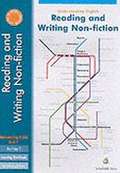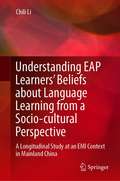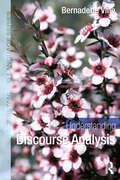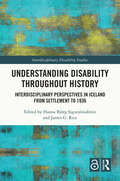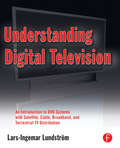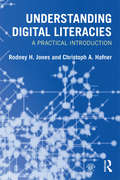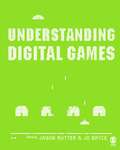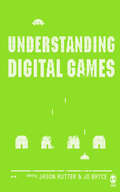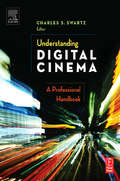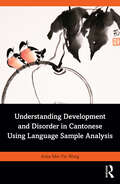- Table View
- List View
Understanding English: KS2 (PDF)
by Carol MatchettUnderstanding English is a series of learning workbooks, each of which features explanations, teaching points, exercises, answers and 'Now you try!' extension activities to ensure that learning is secure.
Understanding Emotions in English Language Learning in Virtual Worlds (New Directions in Computer Assisted Language Learning)
by Mariusz Kruk Miroslaw PawlakThis book contributes to overcoming the deficit in research on emotions in foreign language learning in the domain of computer-assisted language learning (CALL) in both traditional and virtual settings. The authors divide emotions into positive (i.e., enjoyment and curiosity) and negative (i.e., boredom and language anxiety) and explore their role in L2 teaching and learning in CALL environments from theoretical, empirical and pedagogical perspectives. The book begins with a theoretical overview of selected issues concerning positive and negative emotions and surveys the studies that have dealt with this issue in L2 learning in conventional settings and CALL. The empirical part of the book is devoted to a research project which explores the experience of positive and negative emotions in learning English in the virtual world Second Life, the relationships of the emotions in question and factors influencing them. The book concludes by recommending a selection of practices which can help maximize the positive emotions and minimize the negative emotions in foreign language learning in CALL environments. This is an important and illuminating read for students and scholars of applied linguistics, second language education and educational technology who are interested in CALL and in incorporating VW/VR-based language learning programs into their studies and teaching.
Understanding Emotions in English Language Learning in Virtual Worlds (New Directions in Computer Assisted Language Learning)
by Mariusz Kruk Miroslaw PawlakThis book contributes to overcoming the deficit in research on emotions in foreign language learning in the domain of computer-assisted language learning (CALL) in both traditional and virtual settings. The authors divide emotions into positive (i.e., enjoyment and curiosity) and negative (i.e., boredom and language anxiety) and explore their role in L2 teaching and learning in CALL environments from theoretical, empirical and pedagogical perspectives. The book begins with a theoretical overview of selected issues concerning positive and negative emotions and surveys the studies that have dealt with this issue in L2 learning in conventional settings and CALL. The empirical part of the book is devoted to a research project which explores the experience of positive and negative emotions in learning English in the virtual world Second Life, the relationships of the emotions in question and factors influencing them. The book concludes by recommending a selection of practices which can help maximize the positive emotions and minimize the negative emotions in foreign language learning in CALL environments. This is an important and illuminating read for students and scholars of applied linguistics, second language education and educational technology who are interested in CALL and in incorporating VW/VR-based language learning programs into their studies and teaching.
Understanding Emerson: "The American Scholar" and His Struggle for Self-Reliance
by Kenneth S. SacksA seminal figure in American literature and philosophy, Ralph Waldo Emerson is considered the apostle of self-reliance, fully alive within his ideas and disarmingly confident about his innermost thoughts. Yet the circumstances around "The American Scholar" oration--his first great public address and the most celebrated talk in American academic history--suggest a different Emerson. In Understanding Emerson, Kenneth Sacks draws on a wealth of contemporary correspondence and diaries, much of it previously unexamined, to reveal a young intellectual struggling to define himself and his principles. Caught up in the fierce dispute between his Transcendentalist colleagues and Harvard, the secular bastion of Boston Unitarianism and the very institution he was invited to honor with the annual Phi Beta Kappa address, Emerson agonized over compromising his sense of self-reliance while simultaneously desiring to meet the expectations of his friends. Putting aside self-doubts and a resistance to controversy, in the end he produced an oration of extraordinary power and authentic vision that propelled him to greater awareness of social justice, set the standard for the role of the intellectual in America, and continues to point the way toward educational reform. In placing this singular event within its social and philosophical context, Sacks opens a window into America's nineteenth-century intellectual landscape as well as documenting the evolution of Emerson's idealism. Engagingly written, this book, which includes the complete text of "The American Scholar," allows us to appreciate fully Emerson's brilliant rebuke of the academy and his insistence that the most important truths derive not from books and observation but from intuition within each of us. Rising defiantly before friend and foe, Emerson triumphed over his hesitations, redirecting American thought and pedagogy and creating a personal tale of quiet heroism.
Understanding Emerson: "The American Scholar" and His Struggle for Self-Reliance
by Kenneth S. SacksA seminal figure in American literature and philosophy, Ralph Waldo Emerson is considered the apostle of self-reliance, fully alive within his ideas and disarmingly confident about his innermost thoughts. Yet the circumstances around "The American Scholar" oration--his first great public address and the most celebrated talk in American academic history--suggest a different Emerson. In Understanding Emerson, Kenneth Sacks draws on a wealth of contemporary correspondence and diaries, much of it previously unexamined, to reveal a young intellectual struggling to define himself and his principles. Caught up in the fierce dispute between his Transcendentalist colleagues and Harvard, the secular bastion of Boston Unitarianism and the very institution he was invited to honor with the annual Phi Beta Kappa address, Emerson agonized over compromising his sense of self-reliance while simultaneously desiring to meet the expectations of his friends. Putting aside self-doubts and a resistance to controversy, in the end he produced an oration of extraordinary power and authentic vision that propelled him to greater awareness of social justice, set the standard for the role of the intellectual in America, and continues to point the way toward educational reform. In placing this singular event within its social and philosophical context, Sacks opens a window into America's nineteenth-century intellectual landscape as well as documenting the evolution of Emerson's idealism. Engagingly written, this book, which includes the complete text of "The American Scholar," allows us to appreciate fully Emerson's brilliant rebuke of the academy and his insistence that the most important truths derive not from books and observation but from intuition within each of us. Rising defiantly before friend and foe, Emerson triumphed over his hesitations, redirecting American thought and pedagogy and creating a personal tale of quiet heroism.
Understanding Early Modern Primary Sources (Routledge Guides to Using Historical Sources)
by Laura Sangha Jonathan WillisUnderstanding Early Modern Primary Sources is an introduction to the rich treasury of source material available to students of early modern history. During this period, political development, economic and social change, rising literacy levels, and the success of the printing press, ensured that the State, the Church and the people generated texts and objects on an unprecedented scale. This book introduces students to the sources that survived to become indispensable primary material studied by historians. After a wide-ranging introductory essay, part I of the book, ‘Sources’, takes the reader through seven key categories of primary material, including governmental, ecclesiastical and legal records, diaries and literary works, print, and visual and material sources. Each chapter addresses how different types of material were produced, whilst also pointing readers towards the most important and accessible physical and digital source collections. Part II, ‘Histories’, takes a thematic approach. Each chapter in this section explores the sources that are used to address major early modern themes, including political and popular cultures, the economy, science, religion, gender, warfare, and global exploration. This collection of essays by leading historians in their respective fields showcases how practitioners research the early modern period, and is an invaluable resource for any student embarking on their studies of the early modern period.
Understanding Early Modern Primary Sources (Routledge Guides to Using Historical Sources)
by Laura Sangha Jonathan WillisUnderstanding Early Modern Primary Sources is an introduction to the rich treasury of source material available to students of early modern history. During this period, political development, economic and social change, rising literacy levels, and the success of the printing press, ensured that the State, the Church and the people generated texts and objects on an unprecedented scale. This book introduces students to the sources that survived to become indispensable primary material studied by historians. After a wide-ranging introductory essay, part I of the book, ‘Sources’, takes the reader through seven key categories of primary material, including governmental, ecclesiastical and legal records, diaries and literary works, print, and visual and material sources. Each chapter addresses how different types of material were produced, whilst also pointing readers towards the most important and accessible physical and digital source collections. Part II, ‘Histories’, takes a thematic approach. Each chapter in this section explores the sources that are used to address major early modern themes, including political and popular cultures, the economy, science, religion, gender, warfare, and global exploration. This collection of essays by leading historians in their respective fields showcases how practitioners research the early modern period, and is an invaluable resource for any student embarking on their studies of the early modern period.
Understanding EAP Learners’ Beliefs about Language Learning from a Socio-cultural Perspective: A Longitudinal Study at an EMI Context in Mainland China
by Chili LiThis book focuses on the dynamic nature of EAP (English for academic purposes) learners’ beliefs about language learning in their shift from an EFL (English as a foreign language) environment to an EMI (English as the medium of instruction) setting in mainland China. It adopts a mixed method paradigm, whose quantitative part aims to capture the general dynamic feature of the selected student population, while its qualitative part attempts to unveil the process of change in beliefs about language learning among the sample. It is hypothesized that the change in their beliefs about language learning is the result of the interplay between the learners’ agency and the mediation of the contextual realities at the institutional and social levels.
Understanding Discourse Analysis (Understanding Language)
by Bernadette VineUnderstanding Discourse Analysis provides students with an accessible and well-illustrated introduction to discourse analysis. Explaining the main terminology and frameworks and presenting key findings of discourse studies, this book: Explores the development of discourse analysis Covers four key approaches to analysing discourse Uses authentic spoken or written texts in all examples Features data from the Wellington Language in the Workplace Project database Includes examples from a wide range of languages from around the world, such as Chilean Spanish, Korean and Serbo-Croatian Written by an active researcher, this textbook is a fascinating and engaging introduction to discourse analysis and is ideal for students studying this topic for the first time.
Understanding Discourse Analysis (Understanding Language)
by Bernadette VineUnderstanding Discourse Analysis provides students with an accessible and well-illustrated introduction to discourse analysis. Explaining the main terminology and frameworks and presenting key findings of discourse studies, this book: Explores the development of discourse analysis Covers four key approaches to analysing discourse Uses authentic spoken or written texts in all examples Features data from the Wellington Language in the Workplace Project database Includes examples from a wide range of languages from around the world, such as Chilean Spanish, Korean and Serbo-Croatian Written by an active researcher, this textbook is a fascinating and engaging introduction to discourse analysis and is ideal for students studying this topic for the first time.
Understanding Disability Throughout History: Interdisciplinary Perspectives in Iceland from Settlement to 1936 (Interdisciplinary Disability Studies)
by Hanna Björg Sigurjónsdóttir James G. RiceUnderstanding Disability Throughout History explores seldom-heard voices from the past by studying the hidden lives of disabled people before the concept of disability existed culturally, socially and administratively. The book focuses on Iceland from the Age of Settlement, traditionally considered to have taken place from 874 to 930, until the 1936 Law on Social Security (Lög um almannatryggingar), which is the first time that disabled people were referenced in Iceland as a legal or administrative category. Data sources analysed in the project represent a broad range of materials that are not often featured in the study of disability, such as bone collections, medieval literature and census data from the early modern era, archaeological remains, historical archives, folktales and legends, personal narratives and museum displays. The ten chapters include contributions from multidisciplinary team of experts working in the fields of Disability Studies, History, Archaeology, Medieval Icelandic Literature, Folklore and Ethnology, Anthropology, Museum Studies, and Archival Sciences, along with a collection of post-doctoral and graduate students. The volume will be of interest to all scholars and students of disability studies, history, medieval studies, ethnology, folklore, and archaeology.
Understanding Disability Throughout History: Interdisciplinary Perspectives in Iceland from Settlement to 1936 (Interdisciplinary Disability Studies)
by Hanna Björg Sigurjónsdóttir James G. RiceUnderstanding Disability Throughout History explores seldom-heard voices from the past by studying the hidden lives of disabled people before the concept of disability existed culturally, socially and administratively. The book focuses on Iceland from the Age of Settlement, traditionally considered to have taken place from 874 to 930, until the 1936 Law on Social Security (Lög um almannatryggingar), which is the first time that disabled people were referenced in Iceland as a legal or administrative category. Data sources analysed in the project represent a broad range of materials that are not often featured in the study of disability, such as bone collections, medieval literature and census data from the early modern era, archaeological remains, historical archives, folktales and legends, personal narratives and museum displays. The ten chapters include contributions from multidisciplinary team of experts working in the fields of Disability Studies, History, Archaeology, Medieval Icelandic Literature, Folklore and Ethnology, Anthropology, Museum Studies, and Archival Sciences, along with a collection of post-doctoral and graduate students. The volume will be of interest to all scholars and students of disability studies, history, medieval studies, ethnology, folklore, and archaeology.
Understanding Digital Television: An Introduction to DVB Systems with Satellite, Cable, Broadband and Terrestrial TV Distribution
by Lars-Ingemar LundstromWith the milestones of Digital TV and HDTV, there arelots of questions to be asked about television of today...Understanding Digital Television explains complex technical systems and solutions in an easyto comprehend manner along with visual 3D graphics. It helps non-technical individuals such asmanagers, executives, general media professionals, as well as TV and home cinema enthusiastsgain a practical understanding of the equipment, technical aspects of digital television, and variousways of distributing. Most examples are from a European perspective, but also include comparisonswith North American systems. This book answers the confusing questions about new devices anddigital formats, what to do when the analog TV transmitters are switched off, watching TV using yourbroadband connection, and much more.
Understanding Digital Television: An Introduction to DVB Systems with Satellite, Cable, Broadband and Terrestrial TV Distribution
by Lars-Ingemar LundstromWith the milestones of Digital TV and HDTV, there arelots of questions to be asked about television of today...Understanding Digital Television explains complex technical systems and solutions in an easyto comprehend manner along with visual 3D graphics. It helps non-technical individuals such asmanagers, executives, general media professionals, as well as TV and home cinema enthusiastsgain a practical understanding of the equipment, technical aspects of digital television, and variousways of distributing. Most examples are from a European perspective, but also include comparisonswith North American systems. This book answers the confusing questions about new devices anddigital formats, what to do when the analog TV transmitters are switched off, watching TV using yourbroadband connection, and much more.
Understanding Digital Literacies: A Practical Introduction
by Rodney H. Jones Christoph A. HafnerAssuming no knowledge of linguistics, Understanding Digital Literacies provides an accessible and timely introduction to new media literacies. It supplies readers with the theoretical and analytical tools with which to explore the linguistic and social impact of a host of new digital literacy practices. Each chapter in the volume covers a different topic, presenting an overview of the major concepts, issues, problems and debates surrounding the topic, while also encouraging students to reflect on and critically evaluate their own language and communication practices. Features include: coverage of a diverse range of digital media texts, tools and practices including blogging, hypertextual organisation, Facebook, Twitter, YouTube, Wikipedia, websites and games an extensive range of examples and case studies to illustrate each topic, such as how blogs have affected our thinking about communication, how the creation and sharing of digital images and video can bring about shifts in social roles, and how the design of multiplayer online games for children can promote different ideologies a variety of discussion questions and mini-ethnographic research projects involving exploration of various patterns of media production and communication between peers, for example in the context of Wikinomics and peer production, social networking and civic participation, and digital literacies at work end of chapter suggestions for further reading and links to key web and video resources a companion website providing supplementary material for each chapter, including summaries of key issues, additional web-based exercises, and links to further resources such as useful websites, articles, videos and blogs. This book will provide a key resource for undergraduate and graduate students studying courses in new media and digital literacies.
Understanding Digital Literacies: A Practical Introduction
by Rodney H. Jones Christoph A. HafnerAssuming no knowledge of linguistics, Understanding Digital Literacies provides an accessible and timely introduction to new media literacies. It supplies readers with the theoretical and analytical tools with which to explore the linguistic and social impact of a host of new digital literacy practices. Each chapter in the volume covers a different topic, presenting an overview of the major concepts, issues, problems and debates surrounding the topic, while also encouraging students to reflect on and critically evaluate their own language and communication practices. Features include: coverage of a diverse range of digital media texts, tools and practices including blogging, hypertextual organisation, Facebook, Twitter, YouTube, Wikipedia, websites and games an extensive range of examples and case studies to illustrate each topic, such as how blogs have affected our thinking about communication, how the creation and sharing of digital images and video can bring about shifts in social roles, and how the design of multiplayer online games for children can promote different ideologies a variety of discussion questions and mini-ethnographic research projects involving exploration of various patterns of media production and communication between peers, for example in the context of Wikinomics and peer production, social networking and civic participation, and digital literacies at work end of chapter suggestions for further reading and links to key web and video resources a companion website providing supplementary material for each chapter, including summaries of key issues, additional web-based exercises, and links to further resources such as useful websites, articles, videos and blogs. This book will provide a key resource for undergraduate and graduate students studying courses in new media and digital literacies.
Understanding Digital Literacies: A Practical Introduction
by Rodney H. Jones Christoph A. HafnerUnderstanding Digital Literacies Second Edition provides an accessible and timely introduction to new media literacies. This book equips students with the theoretical and analytical tools with which to explore the linguistic dimensions and social impact of a range of digital literacy practices. Each chapter in the volume covers a different topic, presenting an overview of the major concepts, issues, problems, and debates surrounding it, while also encouraging students to reflect on and critically evaluate their own language and communication practices. Features of the second edition include: • expanded coverage of a diverse range of digital media practices that now includes Instagram, Snapchat, TikTok, Tinder, and WhatsApp; • two entirely new chapters on mobility and materiality, and surveillance and privacy; • updated activities in each chapter which engage students in reflecting on and analysing their own media use; • e-resources featuring a glossary of key terms and supplementary material for each chapter, including additional activities and links to useful websites, articles, and videos. This book is an essential textbook for undergraduate and postgraduate students studying courses in new media and digital literacies.
Understanding Digital Literacies: A Practical Introduction
by Rodney H. Jones Christoph A. HafnerUnderstanding Digital Literacies Second Edition provides an accessible and timely introduction to new media literacies. This book equips students with the theoretical and analytical tools with which to explore the linguistic dimensions and social impact of a range of digital literacy practices. Each chapter in the volume covers a different topic, presenting an overview of the major concepts, issues, problems, and debates surrounding it, while also encouraging students to reflect on and critically evaluate their own language and communication practices. Features of the second edition include: • expanded coverage of a diverse range of digital media practices that now includes Instagram, Snapchat, TikTok, Tinder, and WhatsApp; • two entirely new chapters on mobility and materiality, and surveillance and privacy; • updated activities in each chapter which engage students in reflecting on and analysing their own media use; • e-resources featuring a glossary of key terms and supplementary material for each chapter, including additional activities and links to useful websites, articles, and videos. This book is an essential textbook for undergraduate and postgraduate students studying courses in new media and digital literacies.
Understanding Digital Games (PDF)
by Dr Jo Bryce Doctor Jason RutterThere are an increasing number of courses on digital games and gaming, following the rise in the popularity of games themselves. Amongst these practical courses, there are now theoretical courses appearing on gaming on media, film and cultural studies degree programmes. The aim of this book is to satisfy the need for a single accessible textbook which offers a broad introductions to the range of literatures and approaches currently contributing to digital game research. Each of the chapters will outline key theoretical perspectives, theorists and literatures to demonstrate their relevance to, and use in, the study of digital games.
Understanding Digital Games
by Doctor Jason Rutter Dr Jo BryceThere are an increasing number of courses on digital games and gaming, following the rise in the popularity of games themselves. Amongst these practical courses, there are now theoretical courses appearing on gaming on media, film and cultural studies degree programmes. The aim of this book is to satisfy the need for a single accessible textbook which offers a broad introductions to the range of literatures and approaches currently contributing to digital game research. Each of the chapters will outline key theoretical perspectives, theorists and literatures to demonstrate their relevance to, and use in, the study of digital games.
Understanding Digital Cinema: A Professional Handbook
by Charles S. SwartzUNDERSTANDING DIGITAL CINEMA: A PROFESSIONAL HANDBOOK is a comprehensive resource on all aspects of finishing, distributing and displaying film digitally. For technical professionals as well as non-technical decision-makers, the book is a detailed exploration of every component of the process, from mastering to theater management. * An overview of digital cinema system requirements* Post production work flow* Color in digital cinema* The digital cinema mastering process* Fundamentals of compression * Security* Basics of audio * Digital distribution* Digital projection technology* Theater systems* The international perspective: Views from Europe, Asia and Latin America* A realistic assessment of the future of digital cinemaWith contributions by:Richard Crudo, President, American Society of CinematographersLeon Silverman, Executive Vice President, Laser Pacific Media CorporationCharles Poynton, Color ScientistChris Carey, Senior Vice President, Studio New Technology, The Walt Disney StudiosBob Lambert, Corporate Senior Vice President New Technology & New Media,The Walt Disney CompanyBill Kinder, Pixar Animation StudiosGlenn Kennel, DLP CinemaPeter Symes, Manager, Advanced Technology, Thomson Broadcast & Media SolutionsRobert Schumann, President, Cinea, Inc., A Subsidiary of Dolby LabsDavid Gray, Vice President, Production Services, Dolby Laboratories, Inc.Darcy Antonellis, Executive Vice President, Distribution and Technology OperationsWarner Bros. Technical Operations Inc. and Senior Vice President, Worldwide Anti-Piracy Operations Warner Bros. Entertainment Inc.Matt Cowan, Principal and Founder, Entertainment Technology ConsultantsLoren Nielsen, Principal and Founder, Entertainment Technology ConsultantsMichael Karagosian, Partner, Karagosian MacCalla Partners (KMP)Peter Wilson, Vice President, Display Technologies, Snell and Wilcox Ltd.Patrick Von Sychowski, Senior Analyst, Screen DigestWendy Aylsworth, Vice President of Technology, Warner Bros. Technical Operations Inc.
Understanding Digital Cinema: A Professional Handbook
by Charles S. SwartzUNDERSTANDING DIGITAL CINEMA: A PROFESSIONAL HANDBOOK is a comprehensive resource on all aspects of finishing, distributing and displaying film digitally. For technical professionals as well as non-technical decision-makers, the book is a detailed exploration of every component of the process, from mastering to theater management. * An overview of digital cinema system requirements* Post production work flow* Color in digital cinema* The digital cinema mastering process* Fundamentals of compression * Security* Basics of audio * Digital distribution* Digital projection technology* Theater systems* The international perspective: Views from Europe, Asia and Latin America* A realistic assessment of the future of digital cinemaWith contributions by:Richard Crudo, President, American Society of CinematographersLeon Silverman, Executive Vice President, Laser Pacific Media CorporationCharles Poynton, Color ScientistChris Carey, Senior Vice President, Studio New Technology, The Walt Disney StudiosBob Lambert, Corporate Senior Vice President New Technology & New Media,The Walt Disney CompanyBill Kinder, Pixar Animation StudiosGlenn Kennel, DLP CinemaPeter Symes, Manager, Advanced Technology, Thomson Broadcast & Media SolutionsRobert Schumann, President, Cinea, Inc., A Subsidiary of Dolby LabsDavid Gray, Vice President, Production Services, Dolby Laboratories, Inc.Darcy Antonellis, Executive Vice President, Distribution and Technology OperationsWarner Bros. Technical Operations Inc. and Senior Vice President, Worldwide Anti-Piracy Operations Warner Bros. Entertainment Inc.Matt Cowan, Principal and Founder, Entertainment Technology ConsultantsLoren Nielsen, Principal and Founder, Entertainment Technology ConsultantsMichael Karagosian, Partner, Karagosian MacCalla Partners (KMP)Peter Wilson, Vice President, Display Technologies, Snell and Wilcox Ltd.Patrick Von Sychowski, Senior Analyst, Screen DigestWendy Aylsworth, Vice President of Technology, Warner Bros. Technical Operations Inc.
Understanding Development and Disorder in Cantonese using Language Sample Analysis
by Anita Mei-Yin WongUnderstanding Development and Disorder in Cantonese using Language Sample Analysis brings together 20 years of research on typical development and Development Language Disorder (DLD) in Cantonese. This book begins with a succinct overview of Cantonese, which is a popular variety of Chinese, a Sino-Tibetan language. The second chapter describes a new framework of the Grammatical Analysis of Cantonese Samples (GACS), which is developed on the basis of functionalist and usage-based theories of language and language development. The third chapter reports on a quantitative analysis, as well as a qualitative description of the development of Cantonese in preschool children using the GACS framework. The book ends with a chapter that presents the linguistic profile of a Cantonese-speaking child with DLD. It also illustrates how to make decisions on intervention targets on the basis of the grammatical and error analysis. The book provides a timely and important addition to the typological diversity of studies in both child language development and disorder. This book is informative for students and practitioners of speech and language therapy, students in early childhood education and Chinese linguistics, and researchers in child language development and disorders.
Understanding Development and Disorder in Cantonese using Language Sample Analysis
by Anita Mei-Yin WongUnderstanding Development and Disorder in Cantonese using Language Sample Analysis brings together 20 years of research on typical development and Development Language Disorder (DLD) in Cantonese. This book begins with a succinct overview of Cantonese, which is a popular variety of Chinese, a Sino-Tibetan language. The second chapter describes a new framework of the Grammatical Analysis of Cantonese Samples (GACS), which is developed on the basis of functionalist and usage-based theories of language and language development. The third chapter reports on a quantitative analysis, as well as a qualitative description of the development of Cantonese in preschool children using the GACS framework. The book ends with a chapter that presents the linguistic profile of a Cantonese-speaking child with DLD. It also illustrates how to make decisions on intervention targets on the basis of the grammatical and error analysis. The book provides a timely and important addition to the typological diversity of studies in both child language development and disorder. This book is informative for students and practitioners of speech and language therapy, students in early childhood education and Chinese linguistics, and researchers in child language development and disorders.
Understanding Derrida, Understanding Modernism (Understanding Philosophy, Understanding Modernism)
by Jean-Michel RabatéThis volume makes a significant contribution to both the study of Derrida and of modernist studies. The contributors argue, first, that deconstruction is not “modern”; neither is it “postmodern” nor simply “modernist.” They also posit that deconstruction is intimately connected with literature, not because deconstruction would be a literary way of doing philosophy, but because literature stands out as a “modern” notion. The contributors investigate the nature and depth of Derrida's affinities with writers such as Joyce, Kafka, Antonin Artaud, Georges Bataille, Paul Celan, Maurice Blanchot, Theodor Adorno, Samuel Beckett, and Walter Benjamin, among others.With its strong connection between philosophy and literary modernism, this highly original volume advances modernist literary study and the relationship of literature and philosophy.
